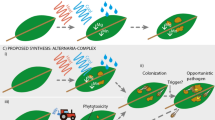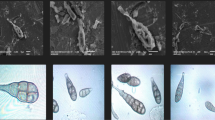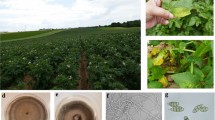Abstract
SEVERAL strains of Alternaria solani (E. and M.) Jones and Grout and one of A. porri (Ell.) Saw. have been found to produce in liquid media a substance which causes a characteristic stunting effect on developing germ tubes of Botrytis allii, in our standard germination test1, without reducing percentage germination. We have also found that germination of spores of other fungi, notably those of Myrothecium verrucaria, is inhibited, so that a more satisfactory assay can be developed. Greatest activity develops in cultures on Czapek–Dox medium containing 10–15 per cent sucrose ; sucrose is appreciably superior to glucose or other sugars. From such culture filtrates, using a strain of Alternaria solani (No. 408 in our collection), we have isolated a material, for which we propose the name alternaric acid, which appears to be responsible for both the antifungal effects mentioned above.
This is a preview of subscription content, access via your institution
Access options
Subscribe to this journal
Receive 51 print issues and online access
$199.00 per year
only $3.90 per issue
Buy this article
- Purchase on SpringerLink
- Instant access to full article PDF
Prices may be subject to local taxes which are calculated during checkout
Similar content being viewed by others
References
Brian, and Hemming, Ann. App. Biol., 32, 214 (1945).
Gilliver, Ann. Bot., 10, 271 (1946).
Neergaard, “Danish Species of Alternaria and Stemphylium’ (Copenhagen, 1945).
Whipple, Wisconsin Univ. Sums. Doct. Diss., 3, 65 (1938).
Thomas, J. Agric. Res., 76, 289 (1948).
Author information
Authors and Affiliations
Rights and permissions
About this article
Cite this article
BRIAN, P., CURTIS, P., HEMMING, H. et al. Alternaric Acid, a Biologically Active Metabolic Product of the Fungus Alternaria solani. Nature 164, 534 (1949). https://doi.org/10.1038/164534a0
Issue date:
DOI: https://doi.org/10.1038/164534a0
This article is cited by
-
Positive selection and functional diversification of transcription factor Cmr1 homologs in Alternaria
Applied Microbiology and Biotechnology (2024)
-
Heterologous expression of a natural product biosynthetic gene cluster from Cordyceps militaris
The Journal of Antibiotics (2022)
-
Antifungal polyketides from the Picea rubens and Vaccinium angustifolium endophyte Lachnellula calyciformis
Mycological Progress (2020)
-
Genome sequence of the potato pathogenic fungus Alternaria solani HWC-168 reveals clues for its conidiation and virulence
BMC Microbiology (2018)



